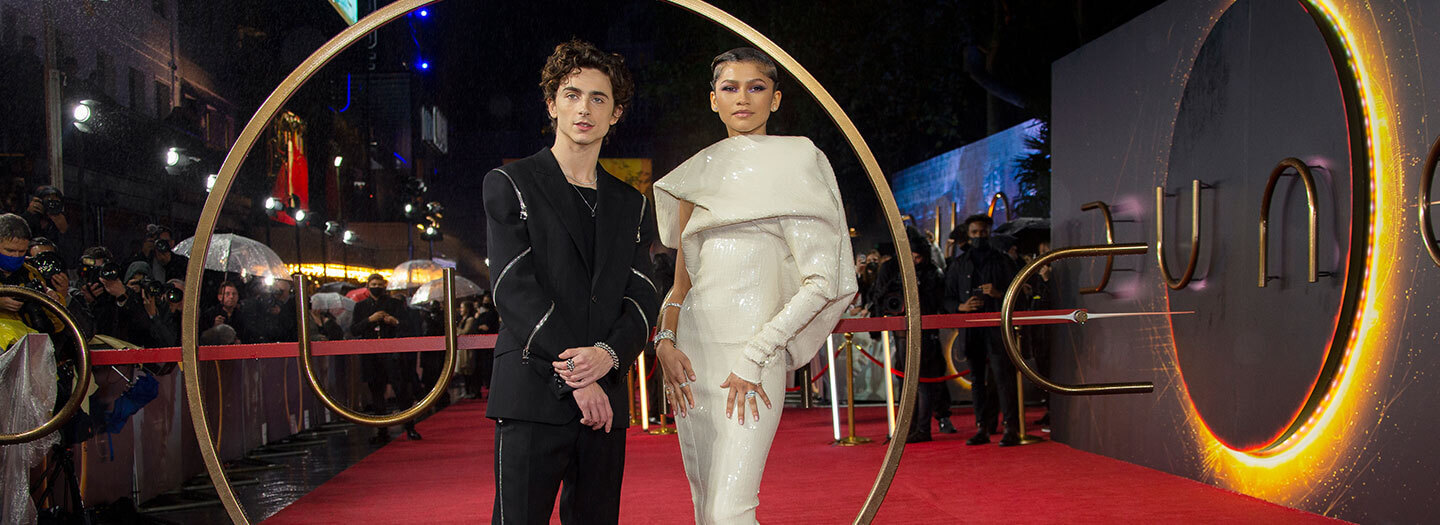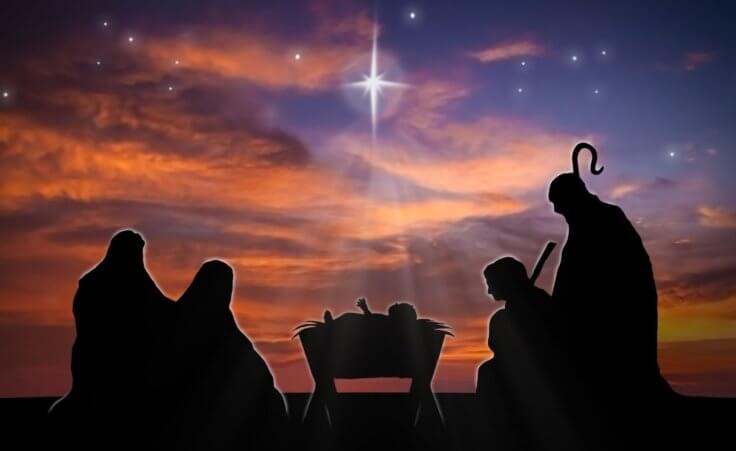
Zendaya and Timothee Chalamet pose for photographers upon arrival at the premiere of the film 'Dune' on Monday, Oct. 18, 2021 in London. (Photo by Joel C Ryan/Invision/AP)
The grand universe of Frank Herbert’s sci-fi classic Dune is set approximately twenty thousand years into the future and has been considered notoriously difficult to adapt to the screen (though it was tried in 1984 and in a 2000 miniseries).
Director Denis Villeneuve brings his grand storytelling skills to bear in the critically acclaimed Dune: Part One. His track record of slow, epic, and visually striking movies includes Arrival and Blade Runner 2049, both of which are also critically acclaimed.
Villeneuve has been a fan of the book since he was fourteen. As such, diligently referred to it for inspiration and consistency. As a fellow nerd, I was not disappointed by the movie. In fact, it was a stunning, faithful representation.
Other reviews have remarked that Dune (written in 1965) is to science fiction what Lord of the Ring is to fantasy.
If that’s so, just as Peter Jackson’s Lord of the Rings films became the definitive rendition of the books, so too will Denis Villeneuve’s Dune become a classic if Part Two—set to release October 20, 2023—lives up to Part One.
“Dune: Part One” is a visually stunning
The casting itself, much less the acting, felt accurate to each character. The movie is brilliantly directed, with every actor stepping into their roles perfectly. Timothée Chalamet leads with detached, royal confidence, interspersed with rich emotional scenes as he plays a young man of fifteen who’s weighed down by unthinkable responsibility.
Because the book is so dialogue-heavy, the movie is able to fill in the color of the story with extraordinary sets, beautiful scenery, and unique wardrobes while remaining faithful to the original work.
As one reviewer phrased it, “You see every dollar on the screen.” (The budget was a whopping $165 million.) The visual effects are breathtaking, every scene a masterpiece of art, each shot a perfectly framed visual. Don’t expect Star Trek-esque, pristine environments though. The movie is as gritty and dark as it is beautiful.
Hans Zimmer’s score feels cluttered at times, but, as always, his genius shines through and matches the cryptic, heavy subject matter with haunting chants in the grand scores.
The movie is weighty and dark, and in some places a bit disturbing. Religion is a focus of the movie (which we will discuss), and there is a moderate amount of violence depicted.
It is not only worth seeing; it is even more worth seeing in theaters.
A quick explainer on the world of Dune
I’ve read the book three times and have seen the movie twice. Yet only now do I feel that I have a good grasp on the complex political groups in this sci-fi universe. It may be helpful for movie-goers to clarify some of the terminology in Dune.
The Emperor who rules over the known universe has balances to his power; namely, the group of Dukes who make up the houses of the Landsraad, ruling over planets like fiefdoms from medieval times.
In addition, there are two independent groups called the CHOAM company (which handles all shipping) and the Space Guild (the only group that knows how to travel between solar systems). They all vie for power and money in a web of intrigue.
You can see where the head-scratching comes from, right? But wait, there’s more.
Lurking in the shadows are the Bene Gesserit, a mystical sisterhood with immense power. Their goals are mysterious, but their primary end is to cross genetic bloodlines of royalty to evolve a super-mind to lead the human race. This savior is called the Kwisatz Haderach. (And this idea is developed in great philosophical depth in the book.)
The Bene Gesserit also possess psychic powers, like forcing people to obey their will, fighting with graceful perfection, and reading people’s intentions.
Dune’s twisting story (Spoilers ahead)
In Dune, the plot follows Paul (Timothée Chalamet), a young heir to the fiefdom ruled by his father, Duke Leto (Oscar Isaac). Paul’s mother Jessica (Rebecca Ferguson), a Bene Gesserit priestess, comes alongside Paul as a mentor throughout the movie. She also believes that he may be the Kwisatz Haderach, finally fulfilling the Bene Gesserit plot that has spanned thousands of years.
The Duke’s house is called Atreides, and they are locked in a centuries-long rivalry with the Harkonnen house, the bad guys of the movie.
At the beginning, the Emperor commands the Harkonnens to give Paul’s father the planet of Arrakis. Arrakis is a harsh desert planet of sandstorms, where the “heat can kill,” and is home to the terrifying, gigantic “sandworms.” This deadly planet is the most valuable fiefdom of all, however, because whoever rules it can mine the ubiquitous “spice.”
Spice is central. It’s extremely valuable as an addictive drug, gives power to people with heightened mental abilities, and is required for intergalactic space travel. Whoever owns Arrakis, then, has the monopoly on spice and gains massive profits. (If you see parallels to oil and the Middle East, you’re not the only one.)
So, the main characters (the House of Atreides) arrive on Arrakis, start mining the spice and try to enlist the help of the fierce desert locals: the Fremen. Duke Leto must build his forces since he suspects the Harkonnens will attack, perhaps with the help of the treacherous Emperor.
Before the Duke can gather enough money and enlist the Fremen to fight against the Harkonnens, the Harkonnens and a hired mercenary force supplied in secret by the Emperor surprise attack in the dead of night. The city is razed and the Duke is betrayed by one of his own.
While the Duke dies, Paul and his mother escape and join with the Fremen in secret, hiding from the Harkonnens, who think they’re dead.
Throughout the movie, Paul wrestles with his developing psychic powers, which give him visions of the future. In his dreams, he sees the mysterious Fremen girl Chani (Zendaya). He also witnesses his terrifying destiny ending in galaxy-wide bloodshed and Jihad committed in his name as the Fremen messiah.
By the end of the movie, when he finally meets Chani in real life, he’s committed to joining the Fremen and potentially even stepping into the messianic prophecy.
Thus ends Part One.
The positive message in Dune
The villain in this film, Baron Vladimir Harkonnen (Stellan Skarsgård), is disgusting and evil in every way. His excessive gluttony, brutal tactics, torture, betrayal, manipulation, and savageness are bad enough; the book adds pedophilia to his list of sins. He is the quintessential bad guy.
In sharp contrast, Duke Leto treats his men with respect and friendship, drawing loyalty from all those around him, including his son. Leto respects the Fremen instead of abusing them like the Harkonnens. In the end, the traitor Dr. Yueh (Chang Chen) ends up helping Jessica and Paul stay alive because of their friendship and his loyalty to the Duke.
Dune may have many lessons to teach us underneath its layers of sand, but the message of loyalty is apparent throughout.
Is religion invented?
The nuances of the book cannot be delved into here, but, suffice to say, the Fremen people are very religious, mirroring Islam and Judaism in interesting ways. Chiefly, they look for a messiah from the outside world to lead them to paradise: the transformation of their desert planet into a garden world. They eventually come to believe that Paul is that messiah.
The trick is that this “religion” was actually invented and planted centuries ago by Bene Gesserit. They have done this all across the galaxy so that they can leverage the religious beliefs of locals to their own ends.
When the Fremen chant the Bene Gesserit name for the messiah, referring to Paul, he cynically remarks in the movie, “They see what they’ve been told to see.”
As is clear, especially in the book, there’s more to it than that. Paul actually fulfills these messianic prophecies. The book seems to cast hope for a savior in a hyper-evolved human mind, thousands of years into the future. This represents a kind of hopeful humanism found in many sci-fi works.
Dune’s ideas are worth exploring
While the intricate politicking, strange names, and complex character arcs can feel overwhelming at first, the rewards from finishing the book and watching the movie are worth every minute. Dune explores philosophy, religion, psychology, politics, ecology, and their interconnectedness, while also developing moving characters and a compelling story.
While fascinating, the portrayal of religion seems to undermine the absolute truth of any religious belief, as is common in science fiction. This is where Jesus, a human but also fully God, gives believers true hope.
That doesn’t mean Herbert’s ideas aren’t worth exploring, I think they certainly are.
And, of course, I highly recommend the Dune film as an enjoyable cinematic masterpiece—if you make it to the theaters.












